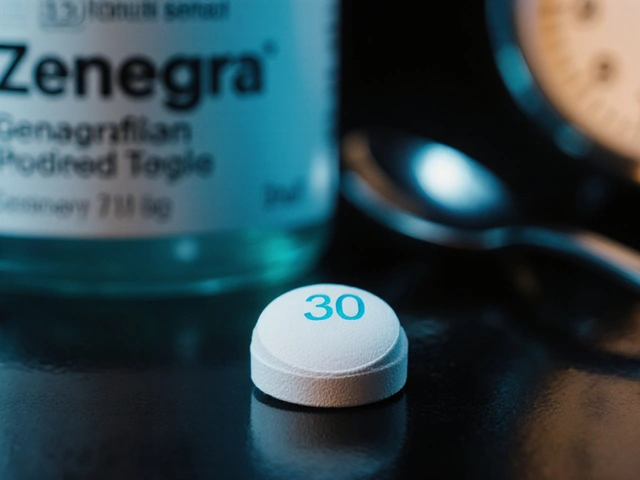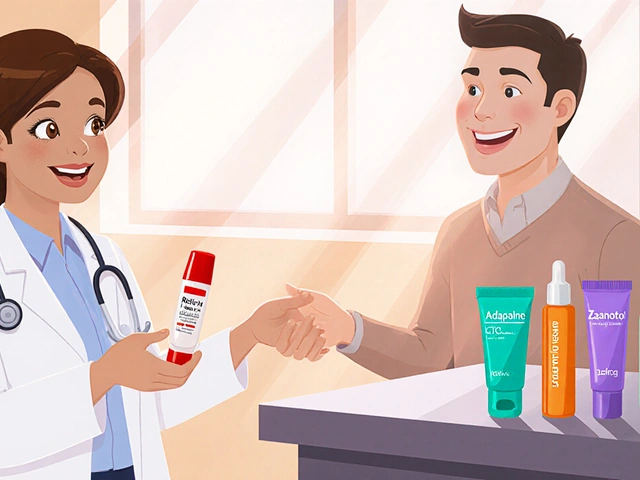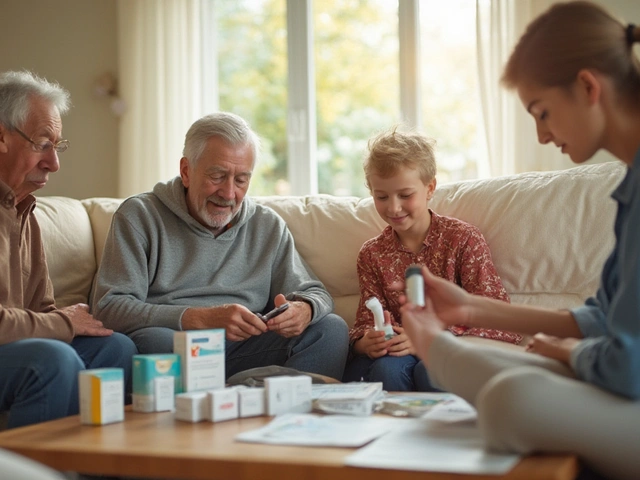Incontinence Medication Selector
Find Your Best Medication Match
Answer a few simple questions to identify the most appropriate medication for your urinary incontinence.
Quick Summary
- Medication is one of three main pillars for treating urine leakage: drugs, behavioral therapy, and surgery.
- Anticholinergics, beta‑3 adrenergic agonists, topical estrogen and duloxetine cover most prescription options.
- Effectiveness ranges from 30‑70% symptom reduction, but side‑effects often dictate the best choice.
- Always pair meds with pelvic‑floor exercises and fluid‑timing strategies for optimal results.
- Consult a urologist or continence nurse before starting any drug-especially if you have chronic conditions.
Understanding Urine Leakage
Urine leakage, medically called urinary incontinence, affects about 30% of adults over 40. The two most common forms are stress urinary incontinence (SUI), where pressure from coughing or lifting squeezes out urine, and urge urinary incontinence (UUI), driven by an overactive bladder that contracts suddenly.
While lifestyle tweaks and pelvic‑floor muscle training (PFMT) can help many, several people need medication to regain control. The right drug depends on the type of leakage, overall health, and how you tolerate side‑effects.
Key Medication Classes
Below are the primary drug families doctors prescribe for bladder control. Each entry introduces the class with a brief definition marked up for knowledge‑graph extraction.
Anticholinergic medication works by blocking the bladder’s muscarinic receptors, which reduces involuntary muscle contractions that cause urgency.
Beta‑3 adrenergic agonist relaxes the detrusor muscle during the storage phase, allowing the bladder to hold more urine without triggering a sudden urge.
Topical estrogen restores thinning vaginal and urethral tissue in post‑menopausal women, improving urethral closure pressure.
Duloxetine is a serotonin‑norepinephrine reuptake inhibitor (SNRI) that increases urethral sphincter tone, primarily helping stress leakage.
Mirabegron (brand Myrbetriq) is a specific beta‑3 agonist that has become a go‑to option for patients who cannot tolerate anticholinergics.
Overactive bladder describes the symptom cluster of urgency, frequency, and nocturia that often drives the need for medication.
Stress urinary incontinence occurs when increased intra‑abdominal pressure overcomes urethral closure, leading to leaking during activities like coughing.

How These Medications Work
- Anticholinergics (e.g., oxybutynin, tolterodine) bind to M3 receptors, dampening involuntary bladder bursts. They are most effective for urge incontinence.
- Beta‑3 agonists (mirabegron, vibegron) stimulate beta‑3 receptors, which tell the bladder muscle to relax during filling. They have a lower dry‑mouth risk than anticholinergics.
- Topical estrogen (cream or vaginal ring) rejuvenates the mucosa, increasing urethral resistance and reducing both stress and urge leaks in menopausal women.
- Duloxetine raises serotonin and norepinephrine levels in the spinal cord, enhancing the reflex that tightens the urethral sphincter during sudden pressure spikes.
Comparing the Main Options
| Medication class | Typical dose | Improvement rate | Common side effects | Best suited for |
|---|---|---|---|---|
| Anticholinergic | 5‑10mg daily (oxybutynin) | 45‑60% | Dry mouth, constipation, blurred vision | UUI, mixed incontinence |
| Beta‑3 agonist (Mirabegron) | 25‑50mg daily | 50‑65% | Elevated BP, headache, nasopharyngitis | UUI, especially when anticholinergics intolerable |
| Topical estrogen | 0.5‑1g cream 2‑3×/week | 30‑50% | Vaginal irritation, mild spotting | Post‑menopausal women with SUI or UUI |
| Duloxetine | 30‑60mg daily | 35‑55% | Nausea, dry mouth, dizziness, insomnia | Predominant stress leakage, especially after pelvic‑floor failure |
Choosing the Right Drug: Decision Checklist
- Identify your leakage type (stress vs. urge vs. mixed).
- Review existing health issues (glaucoma, uncontrolled hypertension, prostate enlargement).
- Consider current medications to avoid drug interactions.
- Assess tolerance for common side effects-dry mouth may be a deal‑breaker for some.
- Discuss cost and insurance coverage; generic anticholinergics are often cheaper than brand‑name beta‑3 agonists.
Managing Side Effects and Monitoring Progress
Even the best‑matched prescription can cause discomfort. Here are practical tips:
- Dry mouth: sip water frequently, chew sugar‑free gum, or use saliva substitutes.
- Elevated blood pressure (mirabegron): check BP weekly for the first month.
- Nausea (duloxetine): take the pill with food and start at the low end of the dose range.
- Schedule a follow‑up visit 4-6 weeks after starting a new drug to gauge effectiveness and adjust dosage.
If side effects outweigh benefits, your clinician may switch to another class or add a non‑pharmacologic approach.
Integrating Medication with Lifestyle Strategies
Medication works best when paired with simple habits:
- Pelvic‑floor muscle training: Perform three sets of 10 squeezes daily. Even with drugs, strengthening the sphincter improves continence rates by ~20%.
- Timed voiding: Schedule bathroom trips every 2-3hours to reduce urgency spikes.
- Fluid management: Limit caffeine and alcohol, which irritate the bladder.
- Weight control: Excess pounds increase abdominal pressure, worsening stress leaks.
When you combine these with a well‑chosen urinary incontinence medication, many patients report a return to normal social activities within a few months.
When to Seek Professional Help
If you experience any of the following, book an appointment promptly:
- Sudden increase in leakage volume or frequency.
- Painful urination, blood in urine, or recurrent UTIs.
- Persistent side effects that interfere with daily life.
- Inadequate improvement after 8-12 weeks on a medication.
A urologist can perform urodynamic testing, rule out infections, and discuss advanced options like Botox injections or sling surgery.
Frequently Asked Questions
Can over‑the‑counter products treat urine leakage?
OTC options like bladder‑support supplements have limited evidence. They may help with mild urgency, but prescription meds remain the most effective for moderate‑to‑severe leakage.
Is it safe to use anticholinergics if I have glaucoma?
No. Anticholinergics can increase intra‑ocular pressure, worsening glaucoma. Talk to an eye specialist before starting these drugs.
How long does it take to notice improvement?
Most patients feel a reduction in urgency within 2-4 weeks, but full benefit may require 8-12 weeks of consistent use.
Can I combine two different bladder drugs?
Combination therapy (e.g., an anticholinergic plus mirabegron) is sometimes prescribed for refractory cases, but it must be overseen by a specialist due to increased side‑effect risk.
Is medication needed for stress incontinence?
Stress leakage often responds best to pelvic‑floor training or surgical slings. Duloxetine is the only approved oral drug, but its use is limited to specific cases.
What should I do if I miss a dose?
Take the missed tablet as soon as you remember unless it’s almost time for the next dose. Never double‑dose; contact your pharmacist if you’re unsure.
Are there natural alternatives to prescription drugs?
Herbal remedies like pumpkin seed extract have modest data, but they’re not a substitute for clinically proven medications when leakage is severe.
Next Steps
1. Write down the frequency, volume, and triggers of your leaks. 2. Schedule a visit with a primary‑care provider or urologist; bring your notes. 3. Discuss the medication classes above, focusing on efficacy, side‑effects, and cost. 4. Start the prescribed drug alongside PFMT and timed voiding. 5. Re‑evaluate after 8 weeks-adjust or switch if needed.
Regaining control over your bladder is usually a stepwise journey. With the right medication and supportive habits, most people experience a dramatic improvement in daily life.





One comment
Picture this: a restless tide of urgency surges, only to be tamed by a pharmacological lighthouse. The dulcet glow of duloxetine or the steadfast shield of anticholinergics can turn the chaotic sea into a placid lagoon. When the bladder rebels, the right molecule steps in like a seasoned conductor, coaxing muscles to obey. Imagine walking into a meeting without the dread of an unexpected leak – that’s the promise of a well‑chosen drug. Yet, without the supporting rhythm of pelvic‑floor exercises, even the brightest beacon will flicker.
In contemplating the ontology of urinary continence, one must consider the interplay between corporeal physiology and pharmacologic intervention. The deliberations presented herein articulate a nuanced taxonomy of agents, each embodying a distinct mechanism of action. It is incumbent upon the clinician to weigh efficacy against iatrogenic sequelae with the rigor of a jurist parsing statutes. Moreover, the socioeconomic dimensions of generic versus brand‑name formulations merit scholarly discourse. Ultimately, the prudent synthesis of medication, behavioral therapy, and surgical options reflects a Cartesian equilibrium.
I hear the frustration of those who live with leaks it can dominate daily thoughts and sap confidence. The science behind anticholinergics or beta‑3 agonists offers hope but it is not a panacea. Pairing medicine with simple pelvic‑floor drills and mindful fluid timing often yields the most sustainable relief.
From a strictly evidence‑based perspective, anticholinergic agents such as oxybutynin function by antagonizing muscarinic M3 receptors, thereby attenuating detrusor overactivity. The pharmacodynamics are well documented, and any deviation from this protocol constitutes a methodological aberration. Our national healthcare framework should unequivocally endorse these therapeutics, provided that prescribers adhere to the established dosing schedules.
It is a travesty that the public is flooded with over‑the‑counter “miracle” supplements while the gold standard of prescription pharmacotherapy is relegated to a niche of the medically literate. One must question the motives of commercial entities that profit from marginally effective nutraceuticals. The rigorous clinical trials behind duloxetine and mirabegron stand in stark contrast to the anecdotal claims of herbal concoctions. Therefore, a discerning patient should prioritize FDA‑approved agents, lest they succumb to the allure of unsubstantiated promises.
Actually, the emphasis on “FDA‑approved” is not merely a bureaucratic checkbox but a safeguard against the quackery you so passionately decry. While your flair is commendable, the reality is that many patients cannot afford premium options and must navigate the generic labyrinth. It is imperative we acknowledge socioeconomic constraints without resorting to melodramatic hyperbole.
Oh joy, another side‑effect checklist that reads like a horror novel – dry mouth, constipation, blurred vision – all while you’re just trying to get to the bathroom in peace. Rest assured, the empathetic team behind these meds understands your plight and will gladly prescribe a spoonful of sugar to sweeten the bitter pill.
The ethical dimension of prescribing-balancing beneficence with non‑maleficence-demands a reflective stance. When a medication alleviates the indignity of incontinence, it simultaneously restores a measure of personal dignity, which is a core virtue in medical practice. Yet, the clinician must remain vigilant of iatrogenic harms, fostering an informed consent dialogue rooted in truth.
Let’s get practical: start a simple bladder diary, note the times and triggers of leaks, and share it with your provider. Incorporate three sets of ten pelvic‑floor squeezes daily, and schedule bathroom trips every two to three hours. These steps, combined with the appropriate medication, often accelerate progress dramatically.
The pharmaceutical industry loves to dress up modest efficacy with glossy marketing, painting beta‑3 agonists as miracle workers while silently pocketing premiums. Don’t be fooled by the hype; scrutinize the raw data, which frequently reveals only marginal superiority over cheap generics. In the end, a well‑chosen anticholinergic can deliver comparable relief without draining your wallet.
While I respect your vigilance against corporate chicanery, it is worth acknowledging that not all patients respond uniformly to anticholinergics; for some, the side‑effect profile is intolerable, prompting a pivot to newer agents despite higher costs. Moreover, the pharmacoeconomic landscape varies across regions, and what appears “expensive” in one market may be subsidized in another, thereby altering the cost‑benefit calculus. Thus, a nuanced, patient‑centered approach that weighs individual response, tolerability, and financial considerations remains paramount.
Quick tip: combine a high‑fiber diet with adequate hydration to reduce bladder irritants-think of it as a dual‑action protocol that synergistically supports medication efficacy. Also, consider using a bladder‑training app to track voiding intervals; data‑driven feedback can fine‑tune your regimen.
Spot‑on summary! 😄
In the spirit of interdisciplinary care, it is essential to integrate urological assessment with pelvic‑floor physiotherapy, behavioral counseling, and, when appropriate, pharmacologic strategies. The convergence of these modalities creates a comprehensive therapeutic matrix that addresses not only the physiological underpinnings of incontinence but also the psychosocial ramifications that often accompany chronic leakage. By fostering collaboration among urologists, continence nurses, and physical therapists, we can tailor interventions to the unique phenotype of each patient, thereby optimizing outcomes and enhancing quality of life.
Oh, the grand tapestry of “collaborative care”-clearly a façade concocted by a shadowy consortium of pharma giants and academic elites to perpetuate dependence on overpriced prescriptions. While you extol the virtues of multidisciplinary teams, the underlying agenda remains profit maximization under the guise of patient‑centeredness.
It is astonishing how the discourse on urinary incontinence often sidesteps the deeper currents of systemic manipulation. One must ask why the narratives surrounding “evidence‑based” medications are perpetually cloaked in jargon that only a select few can decode. The truth, as I see it, is that large pharmaceutical conglomerates have woven a lattice of influence that extends from research funding to guideline committees. This covert architecture ensures that newer, more expensive drugs like mirabegron dominate the market, even when older generics perform just as well. Meanwhile, the patient is left navigating a labyrinth of marketing spin and intimidating medical terminology. The very concept of “shared decision‑making” sometimes feels like a veneer masking a predetermined agenda. In my humble estimation, the key to true empowerment lies in demystifying these opaque processes and reclaiming agency over one’s own health. By critically examining the provenance of clinical trial data, we can uncover patterns of selective reporting that favor profit over patient welfare. Moreover, the relentless push for “new” therapies often eclipses time‑tested lifestyle interventions that deliver sustainable benefits. It is not merely about prescribing a pill; it is about fostering a holistic paradigm that acknowledges the mind‑body nexus. Therefore, I urge fellow seekers of truth to question every recommendation, no matter how polished the presentation. Let us champion transparency, demand open‑access data, and support clinicians who prioritize cost‑effective care. In doing so, we can dismantle the monopolistic grip on treatment options and restore balance to the therapeutic ecosystem. Together, we can transform the narrative from one of passive consumption to active, informed participation.